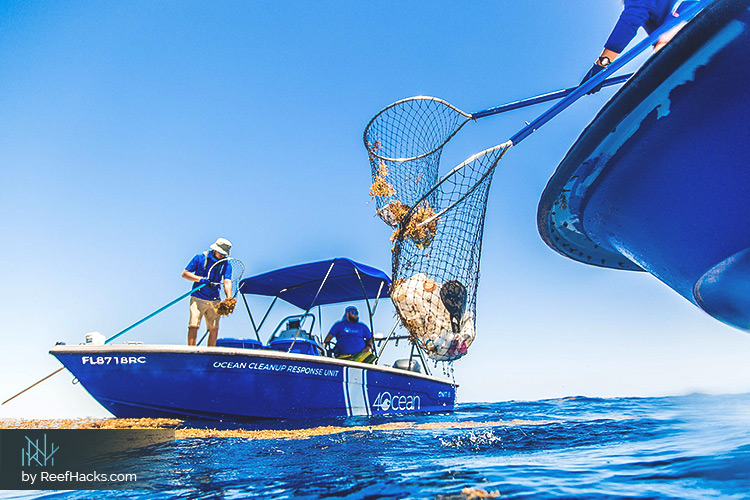The ocean, and all its inhabitants, form the foundation of life. Within its mysterious depths and breathtaking vistas, our oceans catalyze existence from the smallest organisms to the largest land-dwelling mammals.
Alas, humanity has abused the veins of this world. The industrial revolution, hailed by many as the greatest era of our species, quietly set the stage for the potential destruction of those who live on land in water.
What is this growing malformation?
One simple word: plastic.

Author:
As a lifelong aquarist, Yuliya has an endless curiosity about our underwater universe. After graduating with a bachelor’s in Environmental Engineering, she transformed her passion into a successful career. While working at the Institute of Environmental Protection in Moscow, her passion for saltwater and reef aquariums only increased. Moving to the United States in 2013, Yuliya embarked on another impactful journey by sharing her unprecedented experience for all aquarium hobbyists ... Read More.
Turning a Blind Eye to the Signs of Calamity.
In modern society, there are two people. The first, witness the growing aggregation of plastic pollution with willful ignorance. After all, until a problem reaches your doorstep, is it even a real problem? The second group, watches with frustration and shock as the oceans continue to be treated like a landfill.
While the growing awareness of oceanic plastic pollution has triggered greater outcry than seen in previous generations, our cries for change seem muted by the declaration of greed and disconnection between humanity and nature.
As our culture removes its immediate reliance on the purity of nature to survive, it’s become easier to forget the food, water and environment responsible for our very existence.
But, as time moves forward and the collective concern for the world’s oceans dissolves with digital distractions, we unknowingly step toward the point of destruction.

Photos of the plastic bottles by Ricardo Bernardo Attribution-NoDerivs 2.0 Generic (CC BY-ND 2.0)
The Decade Plastictopia Was Born.
At the turn of the 21st Century, society was busy preparing for the new millennium. As the clock effortlessly ticked into the Year 2000, a shockwave of innovation and progress moved throughout the world. Unfortunately, this echoing boom of technology carried more than easier communication methods and cool gadgets.
Hidden behind the glow of our new digital utopia, a new world formed. What was this new formation? Plastic.
Between the Year 2000 and 2010, manufacturers produced more plastic than in the entirety of human history.
Think about that. In only 10 years, we overshadowed the total production of plastic since this “wonder” material first found its way into the lives of humankind.
So, what’s the big deal? Shouldn’t we celebrate this milestone as a testament to the grandeur of modernization and digital transformation?
In an ideal world, yes, but we exist in a realm that’s far from ideal.
You see, dear reefer, it’s not simply the act of plastic manufacturing that’s posing such a risk, it’s what happens to the billions of pounds of plastic produced every year.
With an estimated 15 to 51 trillion pieces of plastic floating throughout our oceans, we’ve willingly established a different world, Plastictopia.

Ocean Plastic Facts - A Story of Cheap Convenience.
So, why are we literally burying ourselves in plastic? This somewhat versatile material is used for a myriad of reasons, but this narrative is one of cheap convenience.
Compared to other materials, plastic is cost-effective to produce and can be used in a wide array of applications. From shopping bags and product packaging, to drinking straws and eating utensils, modern life is seemingly built upon this non-decomposing throne.
Grasping the impact of unfathomable plastic pollution quantities is part of the problem. Actually considering the environmental destruction of an event when the numbers are in the trillions is like trying to comprehend the distance between galaxies, it’s impossible.
Nonetheless, ignoring reality because of its overwhelming scope is an unsavory recipe.
Here’s the dirty truth about ocean plastic pollution:
- 18 billion pounds of plastic flow into our oceans every year (Source: National Geographic)
- Fish living in the North Pacific consume up to 24,000 tons of plastic material every year. Resulting in devastating injuries, death and disruptions to food chain balance as smaller fish concentrations are reduced, which limits food accessibility for larger marine life. (Source: Center for Biological Diversity)
- By the year 2025, researchers believe the total amount of plastic may be three times as much as today, which breaks down to roughly 5.25 trillion pieces of plastic. (Source: IFL Science)
- Between the years 1970 and 2012, researchers noted a 49% decrease in marine vertebrate populations. (Source: IFL Science)

Even within these limited statistics, it’s easy to understand the current state of affairs. However, the implications of plastic usage delves far beyond environment.
While safeguarding the underwater universe that powers the world is paramount for current and future generations, the world’s commitment to plastic influences economic and financial realms. Considering 95% of worldwide trade takes place on the sea, plastic islands are proving problematic for safe passage.
Interestingly, the rise in ocean plastic pollution is harming the very same industries that take part in its severity.
The Ocean Economy, such as fishing, is expected to grow in size and necessity. Unfortunately, as plastic makes its way into the delicate marine habitats, its presence reduces fish concentrations due to injury and death. This, of course, triggers an unsavory chain reaction throughout the marine life universe.
But, what can we, as reefers, do to stop this growing malformation from destroying the world’s we cherish? Along with eliminating our use of plastic products, and advocating a plastic-free marketplace, there’s hope bubbling from quite an unexpected source.

4Ocean - Transformation Worth Wearing.
Answering the plea from both mankind and marine life, 4Ocean is transforming the concept of plastic removal and recycling.
Throughout the past several years, a number of cleanup organizations and businesses have set out to combat the plastic tsunami. From mega-collection nets to innovative recycling concepts, millions are dedicated to stopping the rise of Plastictopia.
So, how is 4Ocean taking a stand against the perpetual onslaught of plastic? One word: bracelets.
Protecting the Environment Never Looked So Good.
Yes, you read that right.
4Ocean isn’t simply recycling collected plastic, but they’re transforming it into a stylish piece of jewelry. Okay, so the concept is pretty cool, but how can fashioning bracelets really make a difference in the plague of plastic?
Let’s find out…

27 Coastlines and Counting - Who Is 4Ocean?
As a hobbyist, it’s impossible to ignore the dangers our coastal reef habitats face. From coral bleaching to complete annihilation of its ecosystem, one of the world’s most beautiful natural wonders is in danger. Since conservation and reefing go hand-in-hand, it wasn’t long until 4Ocean popped up on my radar.
After digging into this organization, it became clear these impassioned environmentalists weren’t look to gain publicity or simply sale recycled jewelry. They’re serious about eliminating the most significant environmental threat of our time.
Founded by Alex and Andrew, 4Ocean began as many other anti-pollution organizations: witnessing the devastation of plastic. As avid surfers and tropical paradise wanderers, their anticipated visit to Bali set the wheels of action in motion. Basking in the brilliance of the Indonesian coastline, they found themselves surrounded by countless pieces of plastic.
The sight of fishermen literally pushing their boats through an unimaginable amount of plastic sparked what’s considered to be the most impactful cleanup companies to date.

Increasing Awareness via Tangible Results.
In a world where tragedy and emotional traumas are unfortunate common stories, proclaiming the horrors of plastic pollution resonates in numb ears. On one hand, it’s understandable. Most of us can only handle so much bad news before we hit the wall of apathy. Combating an increasingly apathetic society isn’t easy, but the team at 4Ocean had an idea capable of boosting awareness, concern and participation.
Why not take back what we put in the ocean, not to be made into more plastic bottles and bags, but something people will cherish?
This is exactly what 4Ocean has done.
Each bracelet removes one pound of plastic from our beloved watery worlds. While this doesn’t seem like a significant impact considering the billions of pounds dripping into our waterways, slow and steady always wins over rushed and impractical.
In the 2 years since its first bracelet, 4Ocean has removed over 816,395 pounds of plastic and trash from our oceans. With over 150 employees and international operations, what started as a desire is resulting in one of the most well-orchestrated ocean cleanups of our time.
To purchase a 4Ocean Bracelet, go to www.4ocean.com and pull your pound of trash from the ocean and coastlines.

Conservation’s Cute… And So Are The Bracelets.
So, 4Ocean’s effectively ridding our waterways, but what about the bracelets? Not only will a single bracelet eliminate one pound of trash, but you’ll actually want to wear it.
As of publishing this article, 4Ocean offers two designs.
The 4Ocean Signature Bracelet is the flagship product. Made out of 100% recycled materials, this low-impact design features dozens of small glass beads strung together on a braided blue string. The beads are crystal clear, which means it works with any outfit (for those who want to help the environment while looking good at the same time).
Throughout the year, 4Ocean often releases limited time bracelets. These special edition designs feature unique color combinations and proceeds help fund the operation and assist in specialty projects. For example, in June 2018, it’s the Sea Turtle Bracelet, which removes one pound of plastic and supports sea turtle conservation efforts.
Definitely keep your eye out throughout the year for these limited edition bracelets. The best way to keep updated with this and other events is via the 4Ocean Facebook Page. Of course, you an also check out the official 4Ocean.com website for this and other relevant information.
While buying a single bracelet makes a significant difference in this entire operation, I really enjoy the monthly subscription plan. Basically, this revolving $20 subscription delivers a new bracelet each month. If you’re looking to actively contribute to the plastic removal cause, this is ideal. Not only are you helping 4Ocean clean waterways throughout the world, but the monthly bracelet is an awesome continued addition to your fashion statement.

Healing Our Oceans, One Bracelet at a Time.
As I’ve continued to work within natural coral reef environments, the need for drastic change has never been greater. Even though it seems small, 4Ocean bracelets are truly making a difference in the health and livelihoods of both man and marine life.
Stop wishing for change. Be the change, and conveniently, wear it.
by Yuliya Ivanova for ReefHacks.

